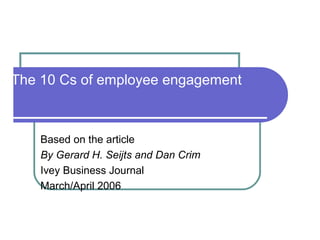
10 cs of employee engagement
- 1. The 10 Cs of employee engagement Based on the article By Gerard H. Seijts and Dan Crim Ivey Business Journal March/April 2006
- 2. What is employee engagement? An engaged employee is a person who is fully involved in, and enthusiastic about, his or her work. Engaged employees care about the future of the company and are willing to invest the discretionary effort – exceeding duty’s call – to see that the organization succeeds. Engaged employees are more productive than their disengaged counterparts. Engaged employees believe that they can make a difference in the organizations they work for.
- 3. Many employees go through their daily grind mechanically but do not bring passion into their work. These people embody what Jack Welch said several years ago : “Never mistake activity- for accomplishment.” Employee engagement has relatively little to do with macro-economic conditions. Instead, it is the unique elements of the work experience that are most likely to influence engagement.
- 4. The 10Cs of employee engagement Connect Career Clarity Convey Congratulate Contribute Control Collaborate Credibility Confidence
- 5. Connect Managers should connect with employees. If relationship with their managers, is fractured, then no amount of perks will persuade employees to perform at top levels. Employee engagement is a direct reflection of how employees feel about their relationship with the boss.
- 6. Career Leaders should provide challenging and meaningful work with opportunities for career advancement. Organizations must provide job rotation for their top talent and assign stretch goals. Are people accountable for progress? Are jobs enriched in duties and responsibilities? Good leaders challenge employees; but at the same time, they instill the confidence that the challenges can be met.
- 7. Clarity Leaders must communicate a clear vision. People want to understand the vision that senior leadership has for the organization, and the goals that leaders or departmental heads have for the division, unit, or team. Success in life and organizations depends critically on how clear individuals are about their goals and what they really want to achieve.
- 8. Convey Leaders must clarify their expectations about employees and provide feedback on their functioning in the organization. Good leaders establish processes and procedures that help people master important tasks and facilitate goal achievement. They also provide feedback.
- 9. Congratulate Employees often receive immediate feedback when their performance is poor, or below expectations. But praise and recognition for strong performance is much less common.
- 10. Contribute People want to know that their input matters and that they are contributing to the organization’s success in a meaningful way. Employees’ understanding of the connection between their work and the strategic objectives of the company has a positive impact on job performance. Good leaders help people see and feel how they are contributing to the organization’s success and future.
- 11. Collaborate Studies show that, when employees work in teams and have the trust and cooperation of their team members, they outperform individuals and teams which lack good relationships. Great leaders are team builders. They create an environment that fosters trust and collaboration.
- 12. Credibility Leaders should strive to maintain a company’s reputation and demonstrate high ethical standards. People want to be proud of their jobs, their performance, and their organization. That is not possible in an unethical organization.
- 13. Control Employees value control over the flow and pace of their jobs . Leaders can create opportunities for employees to exercise this control. Leaders must consult with their employees with regard to their needs. Key questions are : Do leaders involve employees in decision-making, particularly when employees will be directly affected by the decision? Do employees have a say in setting goals or milestones that are deemed important? Are employees able to voice their ideas?
- 14. Confidence Good leaders help create confidence in a company by being role models for high ethical and performance standards.
- 15. Conclusion There is a compelling case for leaders to make employee engagement one of their priorities. Leaders should actively try to identify the level of engagement in their organization, find the reasons behind the lack of full engagement, strive to eliminate those reasons, and implement behavioral strategies that will facilitate full engagement. These efforts should be ongoing. Employee engagement is hard to achieve. If not sustained by leaders, it can wither with relative ease. If sustained, it gives an unmatched competitive advantage.
